If you are new to your online family research you may be ready to or have already started a free account at Ancestry.com to begin your search. This is my 3rd year using Ancestry.com to build my family tree and do my online research. I’ve learned several great tricks about using the site that I would love to pass on to anyone who is new to it or who is having trouble getting “hints” on their family tree.

DATA ENTRY METHODS: Get the HINT!
Success on Ancestry.com only comes when you have established a connection to their data entry methods. I’ll cover some very simple adjustments step-by-step you can make on Ancestry.com to achieve better success on finding hints and information on your family tree.
In this post I’m going to cover the following items:
1) Date Formatting
2) Place Formatting
3) Punctuation
- BIRTH & DEATH DATE FORMAT:
Ancestry.com uses the following date format for researching birth and death dates:
DAY of the MONTH followed by 3 letter abbreviation for the MONTH and then the YEAR. Let’s take a look at one of my cousins, Sarah Pabodie Coe. Notice how the birth date is listed as 7 AUGUST 1656.
Ancestry.com likes their dates to be in the format of 7 AUG 1656. Notice the two formats below. Notice how it shows me a pop up “preferred date format” as I’m editing this information in the “death date” box.
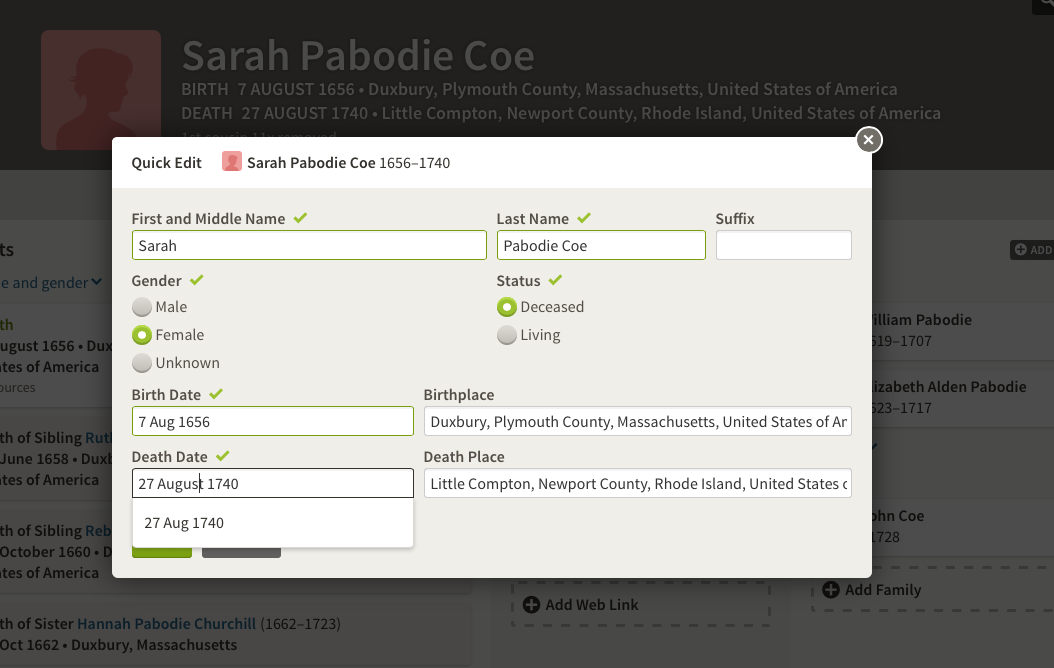
All I need to do is “click” their suggested date and “VIOLA!” now Ancestry.com will be able to further match information to this ancestor because my date formatting is matching their date formatting. You might be amazed but changing just this date formatting in your tree will open up tons of new information that you were missing!
2. PLACE FORMATTING:
This data entry issue exists for “place” data formatting. Let’s look again at editing Sarah Pabodie Coe’s birth and death locations. As I am entering the information Ancestry.com automatically gives me a pop up menu with several options in their formatting. I prefer to use the last and shortest option on all of mine which is:
City – keep it simple – us St for “Saint”
County – here we don’t need to include the word “county”, just give the name.
State – Ancestry.com prefers to spell out the entire state so I follow that as well.
Country – I prefer “USA” just because it follows their formatting and it makes it shorter and more concise but “United States of America” is also acceptable.
*Additional Note on “County”– you may need to use the word County for early established counties before states were formed.
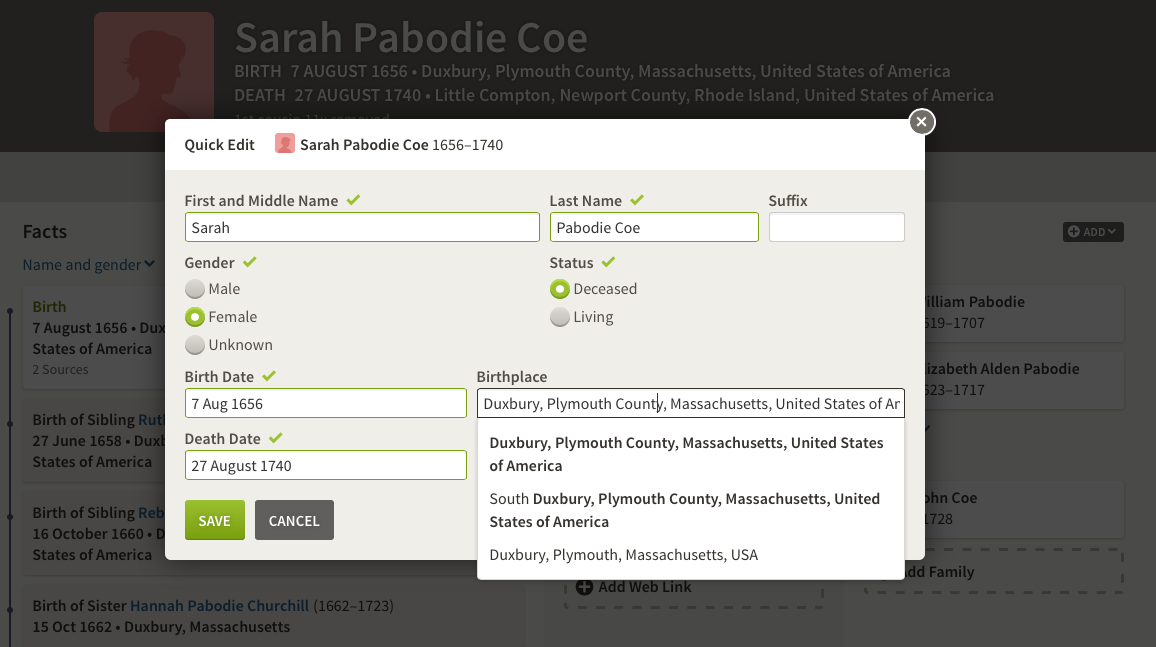
Again, I just click on their 3rd option in the pop up menu and “VIOLA!” now I am connected to Ancestry.com’s hint machine; hopefully unlocking those new hints because we now share the same data formatting.
Let’s go back now and look at the edited information for this cousin.
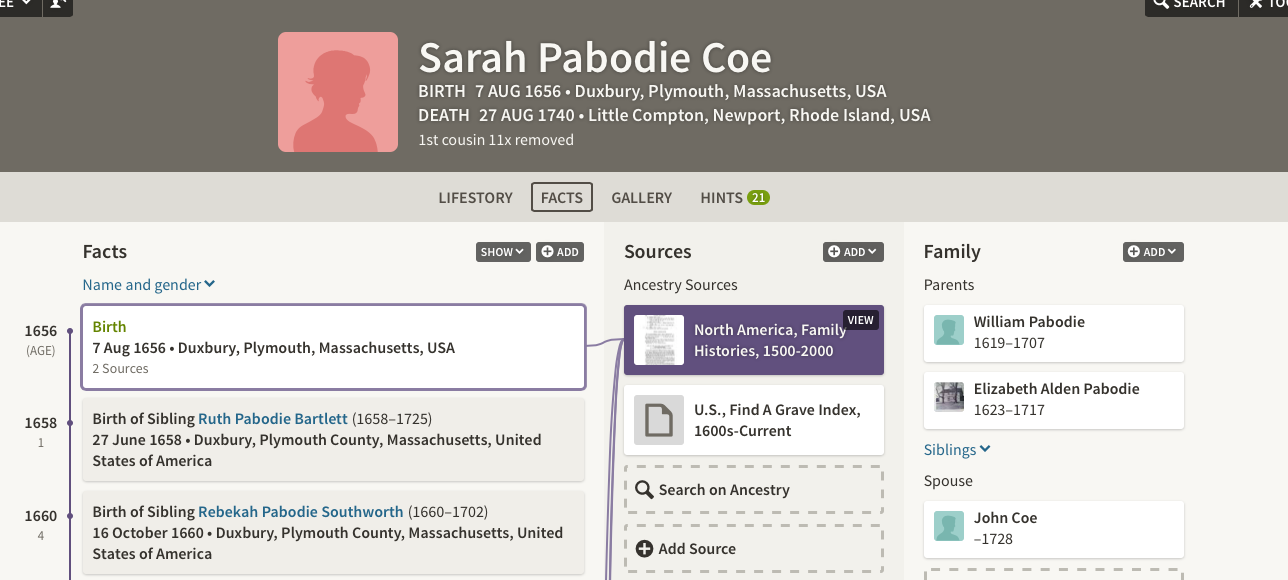
3) USE THE FOLLOWING SPARINGLY: PUNCTUATION!,(?)-“
- COMMAS, PERIODS, HYPHENS, BACKSLASHES, *, #
- “ABOUT”, ABT”
- “UNKNOWN”
A lot of people use too much punctuation and the words “About” or “ABT” and “UNKNOWN” when they are coming up on something of an “unknown”. Unfortunately ancestry.com doesn’t use any of those formats in their search engines. Avoid putting these in a persons’ important information to find more “hints”. Ancestry’s search machine likes the format “Abt.” And “Bef.” If you are making guesses at dates. Keep all punctuation out of your data entry fields to return more matches. A simple ? Or , or * or period could be the single thing that is keeping you from that elusive document!
Here are some great examples of data entry formatting that does NOT match Ancestry.com’s search engine.
Notice how the date formatting on all of these entries are incorrect.
AVOID COMMAS and OTHER EXTRA PUNCTUATION:
Remember you are doing a DATA ENTRY format when you use a family tree building program. Punctuation can be avoided for the most part because each thing you are entering uses it’s own entry box as you type. There is no need to use commas or periods and it will not help you because Ancestry.com’s search engine parameters will ignore matching your entries because it is not searching for entries that start with a “,”. A lot of people will put a “comma” in place of missing information. If you have unknown information its just best to leave it completely blank vs. putting in random words like “ABOUT” or “ABT” or “UNKNOWN” or other punctuation. Here are some examples of this “incorrect” data entry.
JUST SAY NO to ( ) & ? Parenthesis & Question Marks:
Here’s an example of using ( ) in the location. Notice how the preferred format of “city, county, state, country” in this person’s entry does not follow ancestry.com’s search engine model. There are a lot of instances of places in the family tree that don’t exist or are now called something else. It’s best to avoid putting this in your person’s main information if you can help it. It would be better to just put this in the notes or add it as an event in your tree if this is something you want to notate in your files. Same issues occur with ? – Question marks.

Remember, Ancestry.com’s search engine follows this format:

Notice the specifics:
DATE is Day, Month (3 letter abbreviation), Year
PLACE is: City, County (exclude the word “county”), State (Spelled out completely), and USA (abbreviated) .
And now Ancestry.com’s search engine is primed to ping you a “hint” when it finds information on this person! And when you look at this person’s profile – you will find you have “hints” to explore about this person.
I hope that outlining these formatting issues helps you to achieve greater success in your research on Ancestry.com. It is time consuming to make these changes, however, you will have greater success in your searching.
To learn get more great tips and help with your ancestry family tree be sure to follow this blog (hit that “follow this blog” button over there….)

Get new posts delivered to your inbox.
Latest from the Blog
Dating Old Photos: Civil War Uniforms {50 Uniforms in 10 Minutes}
Dating Old Photos: Civil War Uniforms {50 Uniforms in 10 Minutes}
1890 U. S. Census: Up in Smoke, Doused in Water
Let’s visit the U. S. Census again; this time the tragic story of the 1890 census.
Preserving Pioneer History: Cemeteries in Nebraska
We have a big problem in Nebraska with our old pioneer cemeteries. Farming continues to encroach on abandoned cemeteries and when those cemeteries are on private property farmers will often destroy the cemeteries. Our cemeteries are protected under state laws, however, only about half of the cemeteries were on the state registry in 2017. An…





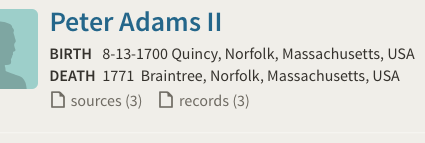


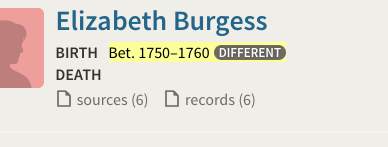


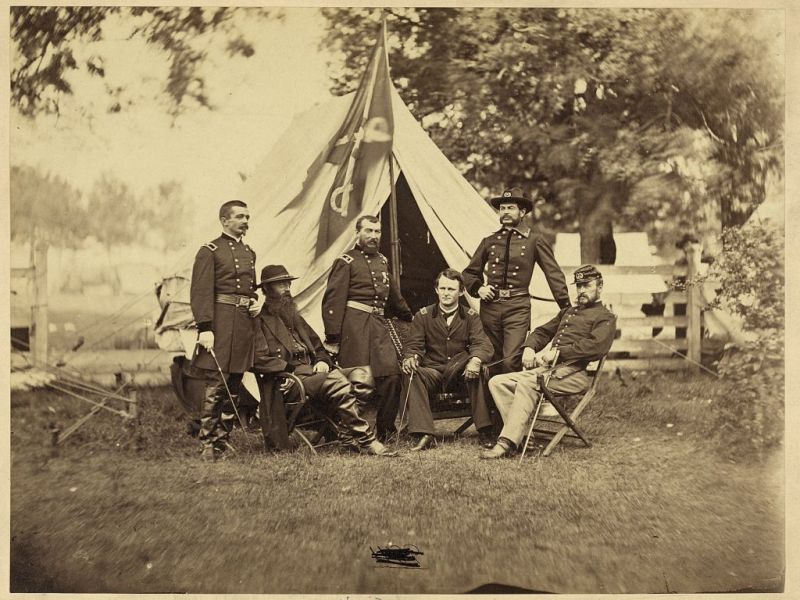


Great information but you didn’t mention that some punctuation marks are acknowledge as wild cards * and ? And how to use them. Great tool when there is a question regarding surname spelling ,
LikeLike
Hi Patricia – in my experience using the ancestry search wildcards characters will kick things out of the search engine completely more often than not. If the document has not been indexed as a “wildcard” character then the search will not find it, period. So for example you are searching “john william?” unless that document as been indexed in that specific way “john william?”, it will not produce any results. You might get a few close possibilities but the only work around I know for this is to add alternate spellings with those wildcard characters into the alternate facts. However, you have to do a lot of guesswork on what those spellings will be. thanks!
LikeLike
Hi! I know I’m years late in finding this blogpost, but I had a question about punctuation in names and locations.
If the location actually has punctuation, even if it’s not immediately recommended by Ancestry? A lot of my family comes from a town called Martin’s Mill. Should it just be Martins Mill?
With names, I always put a period after initials and if there’s a “Jr.” Should I leave those out? Also on names, should nicknames be included? I don’t use parentheses for that, but I do use quotations. i.e. Jacob Elias “Little Jack”.
LikeLike
Hi – sorry it’s late on this but yes, no punctuation in the names – but you should also add “alternate Names” into your facts with those punctuations so that the search engine can also look for those options. ultimately you have to go with one option but always put alternates into your facts for better searching. thanks!
LikeLike